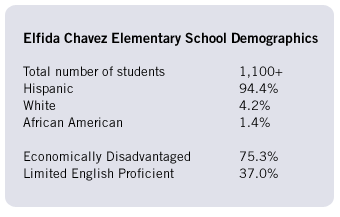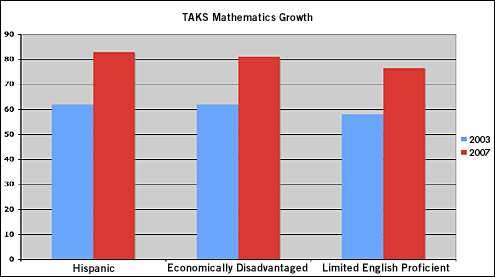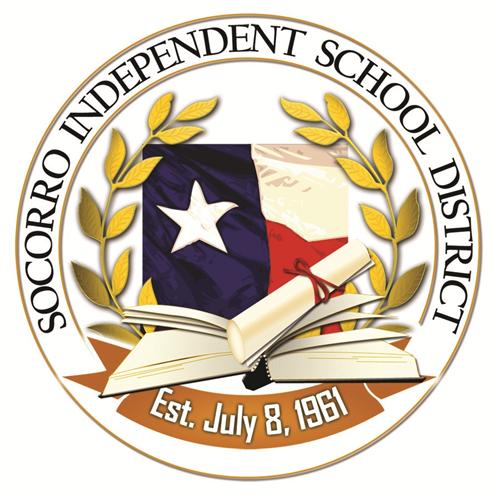District Profile

The Story of One School—Elfida Chavez Elementary
In 2004, a collaboration to improve math instruction began between Socorro Independent School District (ISD) and Math Solutions Professional Development. We first profiled Socorro’s progress in 2005. This update features the leadership and teachers at Elfida Chavez Elementary and highlights significant aspects of their journey to shift math instruction and improve student learning.
Background
Socorro ISD is a fast-growing district in El Paso County, Texas. Under the leadership of Instructional Specialists Sandra Garza and Cynthia Stone, a partnership with Math Solutions Professional Development was launched in 2004 to improve students’ attitudes toward learning math and to increase student achievement. Participants in the multitiered approach to professional development included administrators, classroom teachers, and curriculum coaches. The partnership with Math Solutions provided:
- in-depth summer courses to help teachers to build content knowledge and pedagogy;
- a school-based math leadership session for curriculum coaches and administrators to establish common perspectives for the district’s mathematics program;
- school-year sessions for curriculum coaches focused on content and planning support, correlated to each nine-week period of the district’s scope and sequence;
- content-targeted sessions for teachers based on testing data;
- focused content and pedagogy support for fifth-grade teachers in need along with a component of classroom coaching; and
- school-year sessions for primary teachers to highlight and strengthen early contributions to students’ math understanding and achievement.
The staff from Elfida Chavez Elementary School took part in this wide array of district-supported professional development and used it to make their vision for math teaching and learning come alive in their school.
Laying the Groundwork for Changing Math Instruction
“The About Teaching Mathematics courses provided opportunity for my teachers to feel the power of best practices for instruction. With so many teachers trained, we had a common vision of what a math class should look and sound like.”
Michelle Barton
Principal
Elfida Chavez Elementary
El Paso, Texas
When Michelle Barton arrived at Elfida Chavez Elementary as Principal in 2001, she found an established learning community of teachers experienced in working together for instructional improvement in the area of reading. Student engagement, learning, and achievement indicated success in building a strong reading program in the school. However, as Michelle walked through classrooms during math lessons, she found the instruction very different. It was highly prescriptive, traditional, and teacher driven. From her own experiences as a math student, Michelle knew this was not instruction that would help students understand math and use it to solve problems. She began to prepare herself and the faculty for the work ahead with a plan that included:
- a clear vision for math teaching and learning;
- active leadership and support for changes in math instruction;
- a faculty study of brain research and how people learn; and
- expectations that teacher learning would transform classroom practice.
Michelle was not alone in launching this effort. During her first year as Principal, Michelle found that Mary Salas, a second-grade teacher in the school, held common views about the teaching and learning of mathematics. Their conversations in that first year established a collaboration that would provide leadership and direction for upcoming shifts in mathematics instruction. Mary’s leadership was key as she moved into the role of the school’s Curriculum Coach at the beginning of the 2002 school year.
Engaging in Professional Development to Support Change
The faculty study of brain research and how children learn provided an important and deliberate context for Michelle and Mary to pose the following question to the faculty:
How closely did math instruction at Elfida Chavez Elementary mirror what they had studied about how children learn?
In ongoing dialogues about mathematics instruction, teachers began to question their perspectives and beliefs. The stage for change was set, and teachers were ready and open to learn about different approaches and strategies. In the course of the next two years, teachers were involved in professional development and gained access to new instructional strategies and resources to support their learning. During this period of time, Michelle and Mary:
- hosted the five-day summer course About Teaching Mathematics I in their school for two consecutive summers;
- managed to involve 90 percent of the faculty in this course and used it as a common frame for improving math instruction; and
- provided teachers with Math Solutions instructional resources to help them implement new strategies in their classrooms.
“I nurtured the learning by providing extended time every nine weeks for grade levels to plan together with the support of our curriculum coach. This was hard to manage but worth the effort. Teachers saw that I valued planning and collaboration, and this time provided a chance for grade levels to build consistency in their program.”
Michelle Barton
However, this was only the beginning.
Moving from a Common Vision to Improved Classroom Practice
While professional development and resources are important to instructional change, attention and direction at the school level is critical in helping teachers put new ideas into practice. In her role as Principal, Michelle used a variety of approaches:
- Math instructional improvement became a key element of the campus action plan.
- Expectations that teachers would implement new learning were clearly communicated.
- Marilyn Burns’s Instructor magazine article “10 Big Math Ideas” was used as a focus for the vision and implementation of changes in mathematics instruction.
- Teachers were released for focused grade-level planning sessions for each nine-week period.
- Observations of math lessons were coupled with reflective conversations to deepen teachers’ thinking about their work.
- Staff engaged in ongoing reflection on the faculty study of how children learn and the implications for math instruction.
- Connections were made to what teachers knew about good reading instruction.
With this level of leadership and direction from her principal, Mary, as Curriculum Coach, found herself with the perfect opportunity to actively and purposefully support teachers. Respecting her as a learner and colleague, teachers looked to Mary for:
“In addition to new math lessons, we built in a coherent focus on instructional strategies. I used the article ‘10 Big Math Ideas’ to establish the nonnegotiable aspects that Michelle expected to see in classrooms. These became our core strategies on which everything else was built.”
Mary Salas
Curriculum Coach
Elfida Chavez Elementary
- support that would help them take their next steps in trying new lessons and new instructional approaches;
- help with making choices to boost students’ learning of the expected TEKS (Texas Essential Knowledge and Skills);
- guidance and expertise during each nine-week period’s grade-level planning session; and
- feedback and collegial conversations about their instruction.
Teachers confidently depended on Mary for good reasons. To her role she brought:
- experience with implementing changes in her own math instruction;
- openness to learning;
- never-ending encouragement, nudges, and support;
- understanding that the process of change takes time; and
- willingness to do whatever it took to help her colleagues.
Impact on Math Instruction and Student Learning
Both Michelle and Mary saw the changes in classrooms at Elfida Chavez. Students were engaged and active participants in their learning. Teachers were carefully focused on the mathematics students needed to learn and used instructional strategies to help them succeed.The focus on math instruction also affected student learning and achievement. From 2003 to 2007, significant increases were made in student achievement on the Texas Assessment of Knowledge and Skills for Mathematics, reported below by subpopulations.

A Final Note
“I have a lot more tools, strategies, and outlooks to use now than I did before. I feel more confident in my abilities and resources.”
Teacher, Grade 5
Elfida Chavez Elementary
At the beginning of the 2007–2008 school year, Michelle Barton and Mary Salas, along with several teachers, left Elfida Chavez Elementary to open a new school, Chester E. Jordon Elementary, also in Socorro ISD. To this new school they bring their background and wisdom in building a learning community of teachers and students. As for math, the process of embracing a common vision is well under way—through school-based professional development for new teachers and through ongoing, purposeful grade-level planning for math instruction.

 All District Case Studies
All District Case Studies 